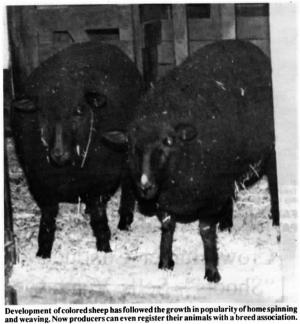1993 - Volume #17, Issue #2, Page #19
[ Sample Stories From This Issue | List of All Stories In This Issue | Print this story
| Read this issue]
Black Sheep Wool Brings Premium Price
 |
But nowadays, black sheep are no longer looked at as just a "marker". Natural colored wool has become popular among home spinners and weavers, and producers can even register their animals with a breed association.
Elaine Vogt, and her husband, Bill, raise sheep near Penn Valley, Calif. About one third of their 70 to 100-head flock are colored.
Ewes vary in color from an almost black to a dark brown with blond highlights on the ends. Some of her animals are registered with the Natural Colored Wool Growers Association, a recognized breed association.
The sheep breed doesn't matter in registration. What's important is that the colored animal was sired by two colored parents. "Every breeder seems to prefer his own breed and that's what the organization was founded for," says Vogt.
But having two colored parents doesn't ensure colored offspring. Vogt says she's had white lambs sired by colored parents, but when those lambs are bred as adults, they frequently produce colored lambs.
The Vogts are working to improve wool quality, pounds of wool produced, and conformation as well as breeding for color. They got started with colored wool in response to demand from customers.
Terry Mendenhall, a sheep producer near Loma Rica, Calif., has also been working to perfect a flock of "black" sheep. From a few colored animals she and her husband started with in 1986, they now have 40 to 50 colored sheep, most with a unique cocoa hue. The remainder of their approximately 120-sheep are white.
Mendenhall says she's been able to identify the gene that carries the chocolate color and has followed it through the animals. "The color is a gene recessive to black and to white," says Mendenhall, a registered nurse who also has a two-year degree in animal science.
The animals may carry the cocoa gene but not exhibit it, but when two carrier animals are bred together, chances are good they will produce chocolate offspring.
In 1990, she predicted she would have 16 cocoa lambs and she had 18. In 1991, she figured on 21 cocoa lambs and she had 26.
Mendenhall has been working mostly with Romney, Rambouillet and Romeldale crosses. "We got into Romneys because we have irrigated pasture, and it's really wet in the winter," says Mendenhall. "Romneys do better when it's wet than fine-haired sheep. And my Romney fleeces sell like fire because they are extremely easy to spin."
A reserve champion fleece from one of her cocoa sheep brought $12.25 a pound at a recent sale in Monterey, Calif.
The development of colored sheep has followed the growth in popularity of home spinning and weaving. But as the spinners became more proficient, they also began demanding a better quality wool and be-came more discriminating. Vogt sells her fleeces locally and through auctions. While a top quality colored fleece may bring $3 to $12 a pound, most go for a lower price. Nevertheless, a colored fleece sold to a spinner will still bring more than white wool sold to commercial buyers, who pay 15 to 20 cents a pound. Colored wool is docked by commercial buyers.
Photo and story reprinted courtesy Ag Alert

Click here to download page story appeared in.

Click here to read entire issue
To read the rest of this story, download this issue below or click here to register with your account number.




